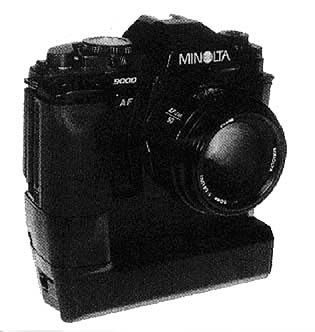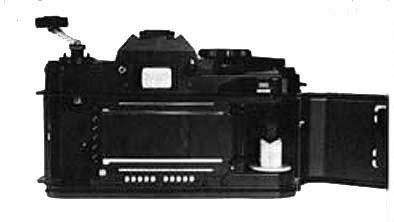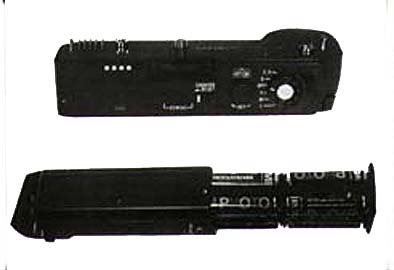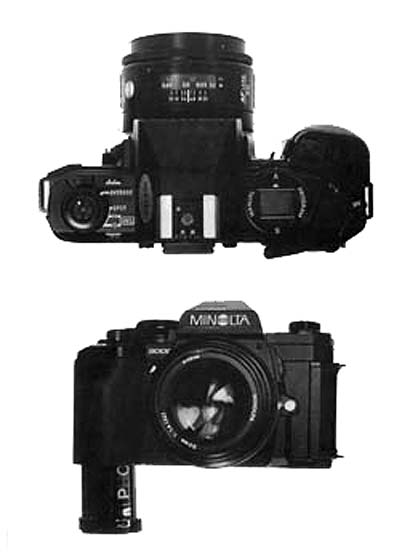
Minolta 9000
...Desirable
and
Dalektable
By Warwick Emerson
Photoworld Magazine
January 1986

Now you're talkin'. Well, not just talking but shouting. This time Minolta really means business!
In PHOTOWORLD Vol. 8, No. 7, we reviewed the Minolta 7000, an outstanding camera. Often, camera manufacturers will produce a flagship and subsequent spin-offs are more budget oriented, but the reverse appears to have been the case with Minolta. The 9000 is a return by Minolta to a more professional approach.
To begin with, the 9000 marks the reappearance of a totally metal body. While modern plastics are capable of taking much abuse, they still don't go down well with professionals. Possibly the reasoning is that pros would prefer a dropped camera to sustain a permanent dent rather than a plastic fracture which may expose the innards to dust and moisture. Whether the reasoning is sound or not, the 9000 certainly feels solid--like a pro camera should. That's not surprising, since the 9000, at 645 gms, is nearly 100 gms heavier than the 7000 body. All this weight is nicely balanced through, with a large handgrip at the front of the right side of the camera. While the comparison with the 7000 is necessary because it is such a significant camera in the market, don't think that the 9000 is simply a beefed-up version of it. Actually, it has been estimated that only about 15% of the components are shared, so the 9000 is virtually a completely new camera.
Why change the 7000 so much? Well, pros are notoriously hard to please and why not? After all, they earn their living with their cameras and must have cameras which are dependable and easy to use (not necessarily simple). Probably the most significant difference between the two cameras is in the way exposure modes are selected. The 9000 uses a more traditional dial marked: 'M' (Manual), 'Program: 'S' (Shutter priority) and 'A' (Aperture priority), rather than push buttons and an LCD panel, as used on the 7000. An LCD panel is used however, to show shutter speed and aperture, in the centre of this dial.
Motor drive is an important component of many professionals' equipment and while the built-in winder of the 7000 is very nice, professionals usually require something faster than the 2 frames per second of the 7000. The motor drive MD-90 provides up to 5 frames/sec. continuous running with the optional NiCad battery pack NP-90M. The standard alkaline battery pack is available separately (more about the motor drive later).
Another important area of difference, as much for serious amateurs as for pros, is in the area of the metering measurement. The 9000 gives you four types of metering, including three types of spot metering. The first type is basic, centre-weighted average metering, similar to many cameras, pro and budget alike. A spot (marked 'SPOT') setting measures 2.7% of the image area only.
Two further biased spot settings, marked 'H' for Highlight and 'S' for Shadow, assist in metering compositions with a strong white (or reflective) or a strong dark (or absorptive) local area, respectively.
Since depth of field, particularly among portrait and fashion photographers, is so important, the 9000 has a depth of field preview lever, just below the shutter release button, on the grip.
The standard power supply for the camera body itself is now two AA-sized cells, the same as the ones found in pocket radios, personal stereos and calculators the world over. It may seem a small point, but since the 9000 has no mechanical back-up shutter speeds, it is important that the power source be easily obtainable.
Detail
As you can see from the pics, one of the first things you notice about the 9000 is its large mode dial. It is delightfully easy to use with one finger and very straightforward. Confirmation of your mode setting also appears in the viewfinder, which means you can change modes without taking your eye away from the viewfinder. More importantly, unlike the 7000, you don't have to push one button down while holding another, which I regarded as a bit of safety over-kill (at the expense of ease of use). The LCD window in the centre of mode dial indicates film speed or exposure compensation when the 'ISO' button or the '+' button on the left of the top plate is held down. Since these controls are used less frequently than the mode control (and since the buttons are easier to push than on the 7000), I found them acceptable.
Shifting exposure values is simple on the 9000. The master control is a spring-loaded lever in front of the mode dial. Pushing it either way increases or decreases whatever appears in the LCD window. In the program mode, the shutter speed and aperture combination can be changed without altering the exposure value. For example, If the camera indicates 1/500 sec, at f8 you can increase your depth of field by pressing the lever until the aperture reaches, say f16, at which point the camera will have matched it with 1/125 sec. shutter speed so that the exposure stays the same. When you have altered the program in this way, the 'P' in the viewfinder flashes to remind you.
In the shutter priority mode, using this lever increases or decreases the shutter speed. Likewise, in the aperture priority mode, the lever increases/decreases the aperture value. In the manual mode, a separate lever, on the left side of the mirror box, operates the aperture. This lever, like the master lever under the mode dial, replaces the two-button approach used in the 7000.
The right-hand end of the top plate on the 9000 is more traditional than the 7000, mainly because the 9000 lacks the built-in motor wind. The film advance lever has a nice feel about it, complemented by a smooth action through its 128" throw, in single or multiple (ratchet) strokes.
Surprisingly, the frame counter has been moved from its display position, in the LCD window of the 7000, to a more conventional mechanical counter in front of the advance lever. Since the 7000 re-lies on a 5-year Lithium cell to maintain the frame counter memory, perhaps it was felt that pros don't yet trust even Lithium batteries for this sort of function.

Turn On
The camera's meter is activated by touching the shutter release button on top of the grip. At the same time, the autofocus circuitry is switched on. The 9000's autofocus differs slightly from the 7000 in that it focuses continually as long as your finger touches the button.
The focus can be held though, by pressing the button halfway down. (The 7000 focuses and then 'locks on: even if the subject moves out of focus again. To refocus, it is necessary to remove your finger from the button and touch it again).
Next to the shutter release, a sliding switch operates a 10-second delay self-timer. Operation of the self-timer is confirmed by both a flashing LED in front of the grip and a high-pitched beeping (which can be muted). The timer is cancelable by simply returning the switch to its 'off' position.
A master power switch, to the right of the advance lever, can be used to turn off the circuits, to prevent accidental pressure on the shutter release (such as in a gadget bag) draining the batteries. This switch also mutes the beeper.
Preview
A nice touch, and one we missed on the 7000, is the depth of field preview lever mentioned earlier. To operate the preview, a tab is folded down to the horizontal position and pressed down a few millimeters. To release the preview, the tab is pushed all the way down and released. The 'F' in the LCD window on top of the camera blinks to remind you that the lens is stopped down. However, this has no effect on aperture and it's nice not to have to return the lever to 'full aperture position, as the preview resets itself when the shutter is fired. Once the lever is operated, exposure and autofocus is locked until either the lever is released or the shutter is fired.
On the back of the camera to the left of the eyepiece, a tiny knob allows dioptre correction of the eyepiece from -3 to +1 dioptres. To the right of the eyepiece, a small, somewhat fiddly lever operates a viewfinder blind. The blind is sensibly coloured red.
Thankfully, the 9000 uses the 7000's location for the AE lock button, on the back of the top panel, just near where the right thumb usually falls. Immediately to the right of this, in an equally convenient location, is a multiple exposure button which is pushed to the left to operate.
Viewfinder
The viewfinder display in the 9000 is very similar to the 7000. Shutter speeds and aperture values are shown in the LCD display but, in addition, there is an indication in the 9000 of whether the camera is set for average or spot metering. Average metering is represented by the outline of a rectangle while spot metering shows a dot (spot) within the rectangle. If exposure compensation is set, the value flashes in the viewfinder.
If you need a reminder of the film speed you have set, this also appears in the viewfinder display if the ISO button is pressed--just like the 7000. The camera back is removable by pulling up on the articulated rewind knob and sliding a safety switch in front of.it to the right. There are contacts galore inside the camera--the usual dozen pins for DX decoding as well as ten below the film guide rails for transmission of data back functions. The inside is simple but well finished and a contrasting white-coloured slotted take-up spool makes loading film in low light easier than many cameras.
Power
Power for the camera is supplied by 2 AA-sized cells which are accessed by a trapdoor in the bottom of the body. It seems a bit strange to us that Minolta should make something more, rather than less, difficult with a pro camera, but with the motor drive fitted, access to the camera's battery compartment is prevented until the motor drive and drive's battery pack are removed. We preferred the 7000's sideways-entry battery compartment.
Motor Drive

The motor drive MD-90 fitted onto our test camera easily, with a simple tripod screw locking action and no cover caps to remove first. The battery pack clips into place underneath the drive unit and is released by pushing a sliding lever on the rear right side of the drive. The MD-90 has 5 speed settings: the usual S (slow), M (medium) and H (high), or settings of 2, 3 and 5 frames per second (5 frames/sec. requires the use of the NiCad battery pack) and S (single frame advance) as well as a setting called F.P., which we originally thought meant Full Power or maybe even Fantasy Photography, as motor drives seem to fulfill many photographers' fantasies, er, aspirations to becoming professional photographers. In fact it means Focus Priority. This means that with the shutter release held all the way down, the camera will not fire on this setting until, and if, correct focus has been achieved.
TEST RESULTS: LENS RESOLUTION
Lens: MINOLTA 35-105mm f3.5-4.5 AF
Date of Test: 7/1/86
AT 1:50 Magnification
Ilford PAN F developed in ID-11@20C
| f /No | Centre: Lines per mm | Corner: Lines per mm | ||
| 3.5 | 44 | Good | 25 | Good |
| 8 | 50 | Very Good | 31 | Very Good |
| 22 | 44 | Very Good | 31 | Very Good |
| 3.5 | 28 | Acceptable | 25 | Acceptable |
| 8 | 31 | Acceptable | 28 | Acceptable |
| 22 | 44 | Good | 31 | Good |
| 4.5 | 35 | Acceptable | 31 | Very Good |
| 8 | 44 | Acceptable | 31 | Very Good |
| 27 | 35 | Acceptable | 31 | Good |
Film advance is continuous in this mode,with a maximum speed of 4 frames per second depending on the focus adjustment required. Although the mode dial on the drive has a double action, it can be set with one finger/thumb and is shrouded to prevent accidental movement. To the left of the mode dial, a 0-36 exposure counter can be set--also by pressing and turning it in a clockwise direction. The drive has power rewind, operated by pressing a rewind button and sliding a switch next to it, to the left. There are five contacts on the back of the drive which allow connection of the 100-exposure film back EB-90 .
Lenses
Our test camera was supplied with a 50 mm f1.4 and a 35-105 mm f3.5-4.5 lens. Although the room is pretty slow at 105 mm and f4.5, we did like its compactness--even compared with non-autofocus lenses--and at a mere 8.8cm (31/2") long at its minimum length, it is quite pocketable. The zooming ring has a good grip and macro mode is easily accessed by sliding a switch on the zoom ring and continuing to turn the ring past the 105 mm setting. The lenses had easily-read distance scales, for those who care about distance, and the focusing rings, although not very wide, were quite easy to use. The 50 mm f1.4 has the same grip material that appears on the zoom's zooming ring, thereby adding to overall secure grip of the camera lens combination. Our lens tests were conducted with the camera set on manual focus. Both lenses showed acceptable resolution quality
Flash

The 4000AF flash is quite an amazing beast. It features the world's first power zoom head, and automatically changes the head's focal length (i.e.flash coverage) according to the focal length of the AF lens being used. Not only that, but if you are using a zoom lens and you change the focal length of the lens, the flash head will zoom along with you! With motor drive, flash and lens doing their own thing, you can imagine the assortment of sounds. Fortunately, it's all fairly quiet. Basic information is supplied on the back of the flash in an LCD panel. This indicates flash focal length and power ratio- as well as auto or manual zooming of the head and whether a diffuser panel is attached. Towards the bottom of the display, manual or TTL metering and flash range (in feet or metres) is shown. Push buttons are used for test, display light, TTL/Manual control and level (power ratio). A red lightning bolt symbol appears, both on the back of the flash and in the viewfinder, when sufficient charge has been reached.
The maximum guide number for this flash is 40 (ISO 100/21"m). The flash head can be rotated and tilted for bounce shots and comes supplied with a wide-angle diffuser for flash shots of 24mm or greater.
The flash has an AF illuminator for low-light subjects which are too dark for the camera's autofocus. Twin beams of infra-red light are sent out to the subject and used by the camera to focus.
Handling

Overall, we felt that the 9000 was a pleasure to use with its more traditional controls. Although it becomes quite heavy with its motor drive and 12 AA sized batteries attached, the shape and size of the total package makes it comfortable to hold for long periods.
The motor sounds fairly unobtrusive in use and the various mechanisms have solid, muted sounds which traditionally mark a quality camera. The rubbery grip around the right side of the camera aids operation with sweaty hands. Rectangular-shaped eyelet's at each end of the camera body allow wrist straps to be attached, increasing security of the camera in unstable conditions.
Low light sensitivity of the autofocus on the 9000 has been lowered to a very fast EV2. This, the minimum slow speed of 30 seconds and the automatic meter display light make the camera an available-light photographer's dream. At the other end of the scale, the fast maximum shutter speed of 1/4000 sec. and flash synch. speed of 1/250 sec. cater for action photographers as well. The new 'focus priority' motor drive mode, combined with autofocus and programmed exposure, totally free the fastpaced photographer--to allow him or her to concentrate fully on composing that all-important shot.
Conclusions
Although the 9000 is aimed at the professional, it may not be aimed at the Nikon F3/Canon F-1/Pentax LX market. The most notable feature that these three cameras have in common is their interchangeable viewfinders; something that the 9000 lacks. Only time will tell if this will affect the 9000's sales Two of the 'big three' (Pentax and Canon) also provide a range of mechanical shutter speeds should the batteries fail. Nikon offers at least one (1/90 second) mechanical speed which should get the powerless photographer out of many jams. We hope, for Minolta's sake, that the use of common AA cells is enough to convince pros to rely on battery power alone with the 9000. In fairness to Minolta, we should point out the long term success of cameras like the Canon A-1, a multi-mode, pro-oriented camera which was totally reliant on batteries (button cells) for its operation, but which still became a very popular camera with professionals.
Perhaps the most important point to emphasize with the 9000, apart from its obvious ruggedness, is its ease of use despite all these additional features. We are pleased to say that after only a few hours of using the 9000, we even preferred it to the 7000, a camera with which we have had six months familiarization and frequent use.
Second Opinion
by David Barnes
If you're looking for a camera with just about every imaginable feature then the Minolta 9000 is for you. It's a pleasure to use. All the controls fall readily to hand, making the joy of photography just that little bit easier And what control you have. Good viewfinder displays coupled with multi mode operation, automatic focusing, a flash that 'sees' in the dark and focuses your lens for you, an optional data back that will automatically bracket your exposures, even an electronic marriage between a zoom lens and a flash. You zoom the lens a little motor zooms the flash!
The true potential of this camera system is only fully realised when it is brought together to operate as one complete unit. the auto focus mechanism is quick and precise. The motor drive, surprisingly, caused very little vibration, even when set at five frames per second. It would seem that the Minolta research team has put a lot of overtime into the design of this camera. In fact, it would almost seem that they have observed the good and bad points of every other camera system on the market, then set about making a camera which had most of the best features of the others, but was still totally unique. Like most cameras though, if you look hard enough, you can find something to criticise. In the 9000's case, to me, it is the lack of mechanical back-up speeds. As a slightly old-fashioned believer in old sayings such as 'if something can go wrong, it will: I hesitate when handed a camera which is so totally reliant on electronics and battery power: I think Minolta has made a small mistake in not including at least one mechanical back-up speed, although this might have entailed some re-design of the aperture system.
On the other hand, it can be argued that if you are using the camera as a complete system, then you will be operating motor drives and flashguns, both of which also require batteries to operate. My only other gripe is also mechanical, or perhaps ergonomic. Focusing the lens manually is difficult--simply due to the small grip on the lens.
Apart from those potential problems, the Minolta 9000 must rate as the most advanced piece of picture-taking equipment to ever come from the company. If you have the wherewithal, and you want it all, it is a desirable and highly functional choice.